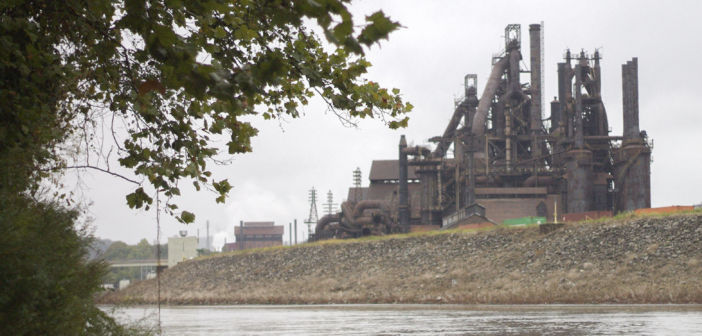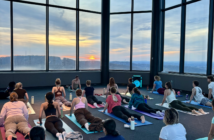The Lehigh River meanders through the heart of Bethlehem.
The water, transportation and resources that the river provides inspired Bethlehem’s first settlers to choose this location and offered the perfect collection of assets for Bethlehem Steel to become the second largest U.S. steel producer in its prime.
The river is the city’s lifeblood, but it is also one of Bethlehem’s major challenges, slashing the city in half and creating a physical barrier between the North and South sides of the city.
The divide between the North Side and the South Side goes far beyond the physical characteristics of the city. Often seen and recognized but rarely put into words, the two sides of Bethlehem have vastly different cultures and socioeconomic backgrounds that make interaction and unity within the city difficult.
“I think it’s not something that anybody says directly, but it’s just something that everybody kind of knows,” North Side resident Justina Uliana said.
The North Side is fairly homogeneous. According to CityData.com, out of approximately 50 Bethlehem districts north of the river, only four have a majority non-white residential population. All of these districts are located along the border of Bethlehem’s city limits, not in the heart of the city.
Out of the 12 districts south of the river, only three have a majority white residential population, with one of those three districts encompassing Lehigh University.
The socioeconomic distribution of Bethlehem tells a similar story.
Excluding Lehigh’s district, which is an outlier in median household income at $60,200, the highest median household income of a district south of the river is $44,200, according to City Data. Conversely, the highest median household income of a district north of the river is over twice that at $102,500.
The causes of this cultural and socioeconomic divide are rooted in Bethlehem’s history.
The North and South sides of Bethlehem were originally completely different cities with their own unique origin stories. According to the Bethlehem Digital History Project, the North Side was founded in 1741 by Moravian settlers, a religious group, and remained an exclusively Moravian settlement until the community was opened to non-Moravians in 1844.
The South Side was formed several years later when it officially became the Borough of South Bethlehem in 1865. According to the South Bethlehem Historical Society, the end of the Civil War brought young workers looking for opportunities to South Bethlehem’s steel and zinc companies and to the newly-formed Lehigh University. The cities remained separate until residents voted to unite the two in 1917.
The cultural and socioeconomic makeup of the North and South sides today is heavily influenced by the origins of Bethlehem, especially the South Side and its industry.
“Historically, it goes way back to the beginning of the city, especially with the steel company,” said Roger Hudak, the chairman of the mayor’s South Side Task Force and a South Side resident. “When Bethlehem Steel first began, most of the workers lived on the South Side and the folks who ran the place lived on the other side of town or up in Fountain Hill in the more wealthy sections.”
The divide between where Bethlehem Steel workers and executives lived fell along the same boundaries of wealth and poverty in Bethlehem today.
Hudak said Bethlehem Steel paid to import ironworkers from abroad. He said because these immigrants mostly settled on the South Side, the area has developed a rich and diverse culture that evolved as Bethlehem Steel imported workers from a variety of countries and as other jobs became available following the closing of the steel mill.
These divides have led to inequality between the two sides of the city that surfaces in several critical ways.
Many South Side residents have problems with public works services such as snow and trash removal and mail service.
Bethlehem councilwoman Olga Negron said this mainly occurs because North Side residents are more likely to complain about failures in service.
“I think all of this comes back to class,” said Seth Moglen, an associate professor of English at Lehigh who has lived on both sides of Bethlehem. “It comes back to economic entitlement and economic power. People with more wealth and more privilege are going to complain if their services aren’t provided and they’re going to demand that their needs be met.”
The inequality between the two sides of Bethlehem also shows itself through stigmas attached to South Side residents. Hudak said he once had a date’s father kick him out of his house saying he doesn’t “allow (his) daughter to go out with people that live over there.”
Moglen said his friends won’t visit his house on the South Side because they think it’s the “hood” and insist that the South Side is dangerous, even though most of his neighbors don’t even lock their doors.
“What they really mean, although they don’t want to say so, is that poor people live in my neighborhood,” Moglen said.
Some attempts have been made to fix these issues while preserving the rich culture of South Bethlehem.
In 2011, the development of SteelStacks and the ArtsQuest campus prompted two of Bethlehem’s most notable festivals, Christkindlmarkt and Musikfest, to expand to the South Side. Christkindlmarkt, which was once located on the North Side, moved entirely to the South Side and Musikfest decided to split its venues between the North and South sides.
President and CEO of ArtsQuest Kassie Hilgert said Musikfest’s move has brought millions in revenue to the South Side. Hudak said the development of the old Bethlehem Steel facilities into the ArtsQuest campus and the Sands Casino has brought between 3,000 and 5,000 jobs to South Bethlehem as well.
However, Negron said while ArtsQuest offers some cultural programming aimed toward South Side residents, not enough programming is offered to form a bond between ArtsQuest and the South Side community.
The recent development in the South Side has helped the community, but poverty is still a major problem on the South Side. Moglen said there is not enough discussion about how to fix poverty in Bethlehem, but the problem could be fixed if poverty is addressed.
“Any talk about bridging that divide that does not attend with the question ‘How do we solve the problem of poverty?’ is just an evasion,” Moglen said. “If no child in South Bethlehem went to school hungry and if every South Side resident could pay their bills, could we still preserve ethnic and cultural distinctiveness? You betcha, we could do that.”






Comment policy
Comments posted to The Brown and White website are reviewed by a moderator before being approved. Incendiary speech or harassing language, including comments targeted at individuals, may be deemed unacceptable and not published. Spam and other soliciting will also be declined.
The Brown and White also reserves the right to not publish entirely anonymous comments.